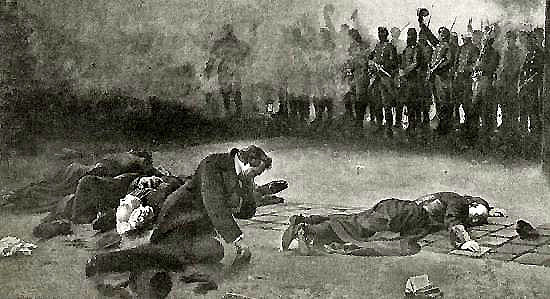ONE "CRIME OF THE COMMUNE," DOES ILLUSTRATE REALITY, THOUGH NOT ALL OF IT
Théophile Ferré, the fanatic whom Louise Michel loved, did order the shootings of the Archbishop of Paris and five other prisoners.
Assassination of the Hostages at the la Roquette Prison / zoom
-- Musée Carnavalet, not exhibited
Ferré was not present but as he ordered the execution, having an actor represent him is fair. Yet showing the other victims as clergy is propaganda, since most were policemen whose names happened to be first on the prison list (My Red Notebooks: a Bit of Truth on the Death of the Hostages, toward 1910).
By Robert Jefferson Bingham, toward 1860 / zoom
Monseigneur
Georges Darboy was a kindly man of humble origin, who defended the poor and tried to limit Versailles's ferocity.
# # #
Thiers was as responsible:
- The Communards wished to exchange Darboy for Auguste Blanqui, France's most famous revolutionary.
Portrait of Louis Blanqui by Eugène Appert, probably 1871 / zoom
- He is remembered for spending 35 years in prison and for the phrase "Neither god nor master:"
A poster in the washroom of a popular restaurant in La Goutte d'Or, 2020
Movie on a slave revolt, 2024
- When leaders of La Commune offered to exchange all 74 hostages for Blanqui alone, Thiers refused.
"You will get them on the sole condition of letting Blanqui go! 74 men in exchange for one ! Just say the word, and I will bring you all of them..
# # #
"Idiot!" cried Victor Hugo he heard that Ferré had given Thiers the high-profile martyr he sought, used again and again:
Photomontage by Ernest-Charles Appert, février 1872 / zoom
Monseigneur Darboy at the prison of La Roquette
 |
| Illustration from a painting by Henri Motte, Internet / disappeared |
This painting was made in 1926...
May 24 1781, Execution of Mgr Darboy and President Bonjean at la Roquette by Marie-Thérèse de la Fosse / zoom
And I heard a countess evoke
the Archbishop's death with emotion
when a full century had passed.
* * *
Next,
















%20%20eng.JPG)







